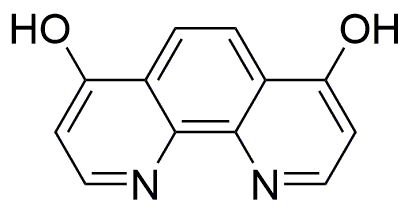4,7-Dihydroxy-1,10-phenanthroline is widely utilized in research focused on:
- Analytical Chemistry: This compound serves as a chelating agent for metal ions, making it valuable in analytical techniques to detect and quantify metals in various samples.
- Biochemistry: It plays a role in studying enzyme activities and interactions, particularly in research involving metalloproteins, helping scientists understand biological processes better.
- Material Science: The compound is used in the development of advanced materials, such as sensors and catalysts, due to its unique electronic properties and ability to form stable complexes.
- Pharmaceutical Research: It has potential applications in drug development, particularly in creating compounds that target specific metal-dependent biological pathways, offering new therapeutic options.
- Environmental Science: This chemical is employed in studies assessing metal contamination in environmental samples, aiding in the development of remediation strategies to address pollution.
General Information
Properties
Safety and Regulations
Applications
4,7-Dihydroxy-1,10-phenanthroline is widely utilized in research focused on:
- Analytical Chemistry: This compound serves as a chelating agent for metal ions, making it valuable in analytical techniques to detect and quantify metals in various samples.
- Biochemistry: It plays a role in studying enzyme activities and interactions, particularly in research involving metalloproteins, helping scientists understand biological processes better.
- Material Science: The compound is used in the development of advanced materials, such as sensors and catalysts, due to its unique electronic properties and ability to form stable complexes.
- Pharmaceutical Research: It has potential applications in drug development, particularly in creating compounds that target specific metal-dependent biological pathways, offering new therapeutic options.
- Environmental Science: This chemical is employed in studies assessing metal contamination in environmental samples, aiding in the development of remediation strategies to address pollution.
Documents
Safety Data Sheets (SDS)
The SDS provides comprehensive safety information on handling, storage, and disposal of the product.
Product Specification (PS)
The PS provides a comprehensive breakdown of the product’s properties, including chemical composition, physical state, purity, and storage requirements. It also details acceptable quality ranges and the product's intended applications.
Certificates of Analysis (COA)
Search for Certificates of Analysis (COA) by entering the products Lot Number. Lot and Batch Numbers can be found on a product’s label following the words ‘Lot’ or ‘Batch’.
Numéro de catalogue
Numéro de lot/série
Certificates Of Origin (COO)
This COO confirms the country where the product was manufactured, and also details the materials and components used in it and whether it is derived from natural, synthetic, or other specific sources. This certificate may be required for customs, trade, and regulatory compliance.
Numéro de catalogue
Numéro de lot/série
Safety Data Sheets (SDS)
The SDS provides comprehensive safety information on handling, storage, and disposal of the product.
DownloadProduct Specification (PS)
The PS provides a comprehensive breakdown of the product’s properties, including chemical composition, physical state, purity, and storage requirements. It also details acceptable quality ranges and the product's intended applications.
DownloadCertificates of Analysis (COA)
Search for Certificates of Analysis (COA) by entering the products Lot Number. Lot and Batch Numbers can be found on a product’s label following the words ‘Lot’ or ‘Batch’.
Numéro de catalogue
Numéro de lot/série
Certificates Of Origin (COO)
This COO confirms the country where the product was manufactured, and also details the materials and components used in it and whether it is derived from natural, synthetic, or other specific sources. This certificate may be required for customs, trade, and regulatory compliance.


